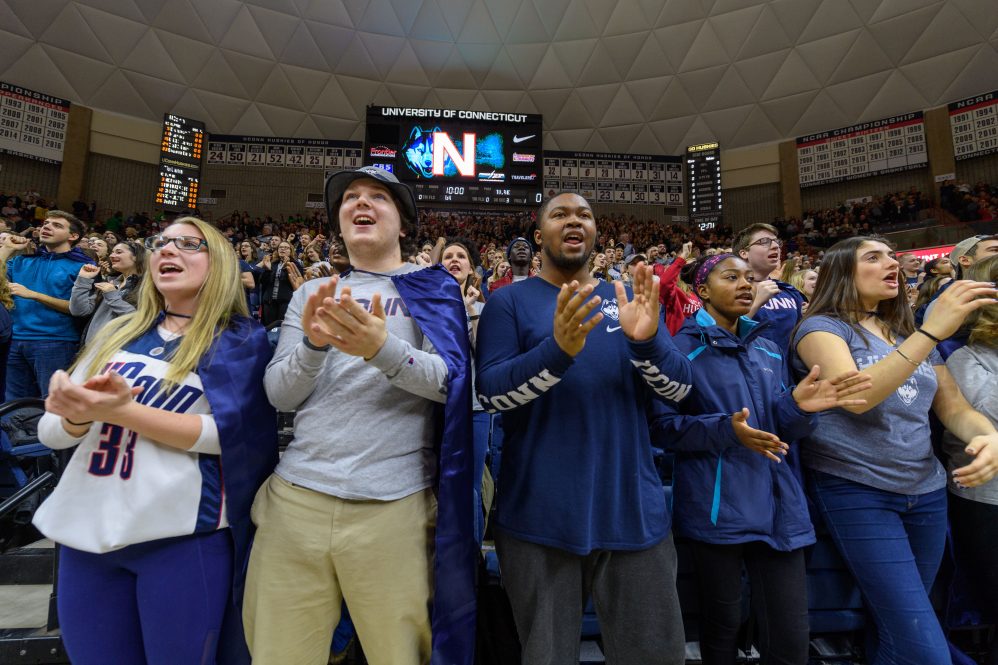For the 70,000 fans who attend Super Bowl LVI in person next month, the experience will be vastly different from the one had by 96 million television viewers watching from home, a new study from a team of UConn researchers finds.
“The idea behind this study was to see whether the experience of being in the stadium or experiencing a live event as a member of a crowd is fundamentally different than experiencing the same event as a member of a crowd remotely,” says Dimitris Xygalatas, associate professor of anthropology. “We see that it does make a difference, it makes a huge difference.”
The study, led by former UConn doctoral student Gabriela Baranowski Pinto ’19 Ph.D., was conducted in Xygalatas’ Experimental Anthropology Lab, in collaboration with a group from Oxford University in the United Kingdom.
Researchers, whose paper “Being in a Crowd Bonds People Via Physiological Synchrony” was published Jan. 12 in the journal Scientific Reports, analyzed data from 182 UConn Husky fans who attended or watched 26 regular season men’s and women’s basketball games during the 2016-17 season. Fans who attended games at Harry A. Gampel Pavilion were outfitted with wearable heart monitors, as were those who watched games in small groups on a 102-inch television in the lab.
The UConn research comes after Xygalatas’ 2011 study of ritual firewalking in Spain found that heart rates among group members synchronized during the act. Now, these findings show that heart rate synchrony equates to improved experience.
“We see that for groups that are in the stadium, their heart rates synchronize more at the group level, their heart rates go up and down at the same time, which means their emotional reactions are aligned. You kind of feel like one,” he says. “We found this in other studies, but now we have more tangible evidence that this is an indicator of social bonding.”
(For anyone wanting to test the research for themselves, the men’s basketball team will take on Georgetown tonight, Jan. 25, at 8:30 p.m. in Gampel Pavilion.)
The study shows the more heart synchrony there is during an event, the more transformative and emotional the experience, Xygalatas says. This leads to greater “identity fusion,” a particularly strong form of social cohesion, for those who experience something en masse.
For each basketball game, students at Xygalatas’ lab noted everything that happened – from baskets and blocks to shots and steals – to account for structural differences between games to see if these affected heart rate synchrony and identity fusion.
“While these properties of the game obviously play a role,” Xygalatas says, “it was actually the social setting that made the greatest difference.”
While work on the study started years before the pandemic, its findings are particularly relevant as governments, organizations, and other groups struggle to decide when to close or reopen to the public in reaction to coronavirus data.
“I’m not a policymaker, there are always costs and benefits. But what our study shows is what those benefits might be, the social benefits of participating in person. Whether those outweigh any health concerns, that’s not for me to say, but the study speaks to the social benefits,” says Xygalatas.
He adds, “The implications are very wide-reaching because this is not just about sporting events, but also concerts, theatrical plays, public demonstrations, and even things like academic conferences and teaching. We all know on some level that it’s not the same to teach remotely. We hope these results will help us figure out why.”
Nevertheless, researchers wouldn’t expect to see the same synchrony during the upcoming Winter Olympics in Beijing next month.
“The Olympics are a little bit different because the games are mostly about individualized sports,” Xygalatas says. “You don’t tend to get the same strong sense of loyalty as you do with other group athletics. You can have fans of particular athletes, and of course those athletes represent countries, but they do not tend to create the same level of cohesion among fans. Some of our future studies might hopefully help us understand why this happens.”
A group watching “Hamilton” on Broadway versus one at home on the couch would have a more transformative experience, however.
“Nobody wants to watch a theatrical play on television. There’s a reason for that,” he says. “The quality of the music on a home stereo is vastly superior to that of a live concert, and yet the experience of attending the live event will be far more impactful for most people. It’s a fundamentally different experience. It does things for people that just listening to music at home doesn’t do.”
Xygalatas also is appearing in season 2, episode 208 of “The World According to Jeff Goldblum,” which was released Jan. 19 on Disney+. In the episode “Birthdays,” Xygalatas talks with Goldblum about firewalking.



